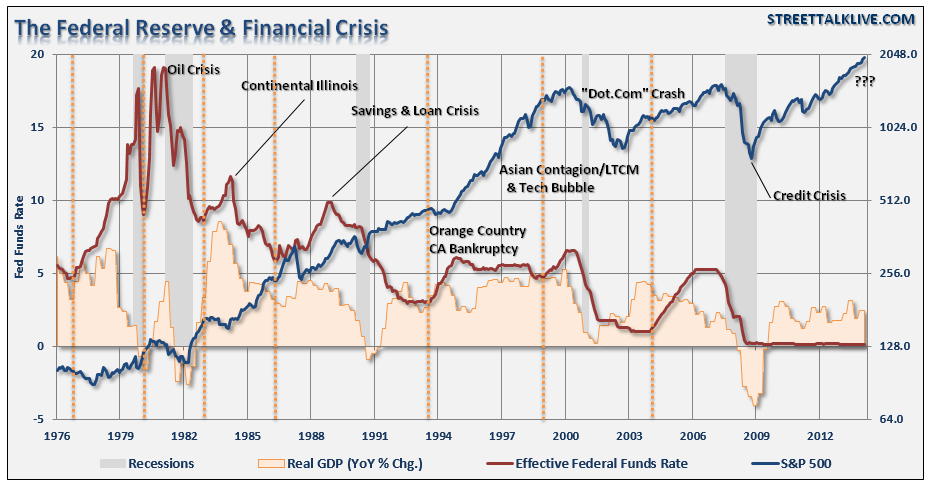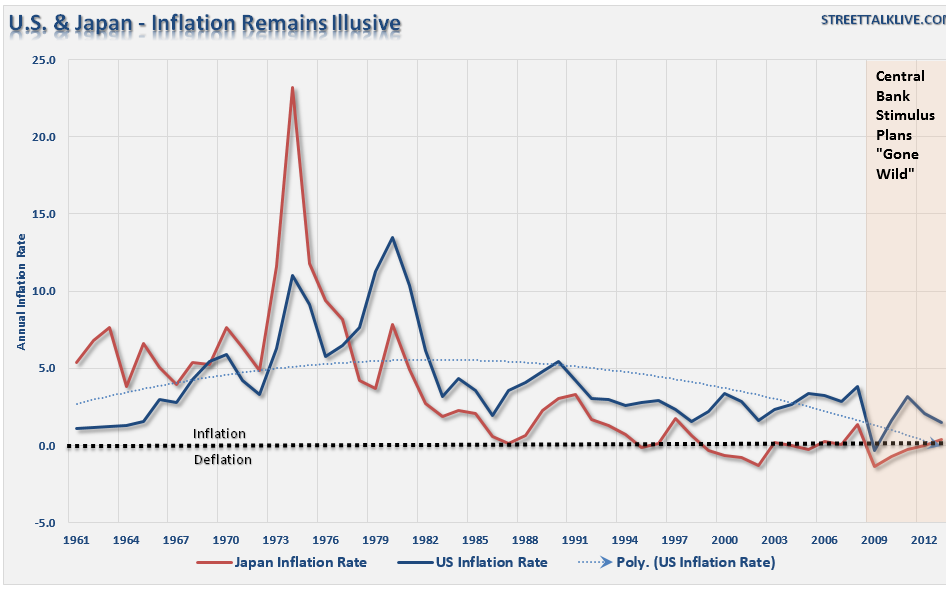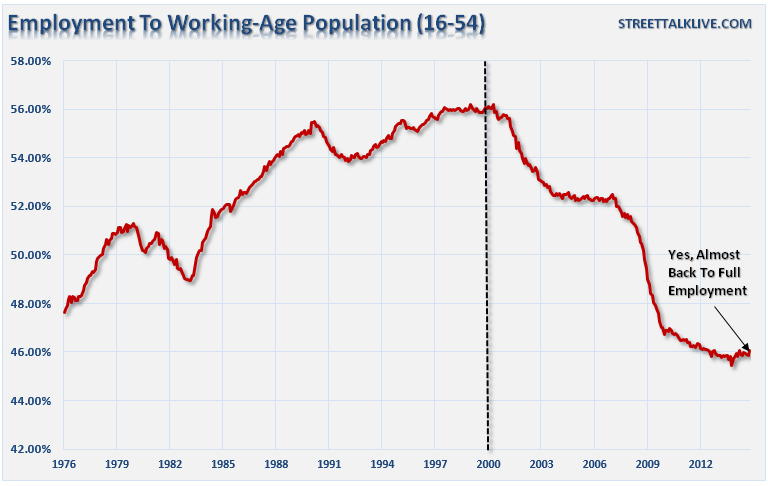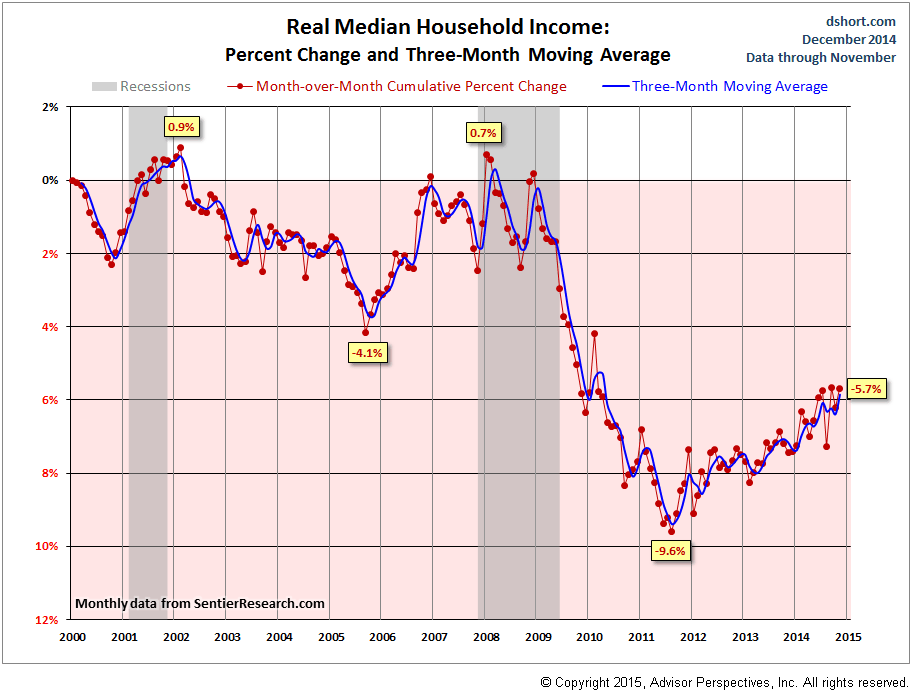The Federal Reserve's biggest worry and, frankly, every Central Banker on the planet, is deflation. The reason is that deflation, as an economic pressure, is dangerous and once entrenched becomes difficult to break. For the Fed, the fear of inflation is far less worrisome. Conventional monetary policy tools, mainly interest rates, can be used to some degree of success to stymie inflationary pressures. The problem is that such actions, as shown below, have ALWAYS led to an economic recession or negative financial consequence.
However, as can be witnessed in both Japan and the U.S., Central Bank monetary policy tools have little effect in reversing deflationary pressures.
For several years, there have been repetitive screams that inflation was imminent due to deficits, a fiat currency and expanding debt levels. Yet, the opposite has been true. The lack of inflation has been a construct of the underlying structural dynamics of the economy. Home ownership rates have plunged, technological advances and productivity increases have fostered wage suppression, and high levels of uncounted unemployed (54% of the 16-54 aged labor force) drag on economic strength.
The exceptionally low yields on government treasuries is clear evidence that inflation is not a threat. For all the money that has been spent trying to ignite the engine of economic growth; it has all remained a futile effort at this point.
Velocity Of Money
The velocity of money is defined by Wikipedia as:
"The average frequency with which a unit of money is spent on new goods and services produced domestically in a specific period of time. Velocity has to do with the amount of economic activity associated with a given money supply."
As the velocity of money accelerates, demand rises and inflationary pressures increase. However, as you can clearly see, the demand for money has been on the decline since the turn of the century.
Employment
Even with all the financial stimulation from bailouts, to QE programs, tax incentives and credits, etc., the velocity of money has waned since the end of the last recession as the economy has sputtered along at sub-par growth rates. Of course, much of that can be attributed to sustained levels of high unemployment which has suppressed both wage growth and aggregate end demand which in turn has kept businesses on the defensive. As discussed previously, the most important segment of the labor force (those between the ages of 16-54) remain largely unemployed.
"Importantly, when the employment-to-population ratio or the labor-force participation rate is discussed, the plunging levels in these ratios are often dismissed simply as a function of the 'baby boomers' heading into retirement. However, if we factor out those individuals by only looking at the employee-to-population ratio of 16-54 aged individuals as a percent of that age group the picture fails to improve."
"While the unemployment rate has certainly plunged to just 5.6%, one would be hard pressed to find that 94.4% of the population that "want to work" are actually working."
Wages
Wages are a critical weapon in defeating deflation. Wages have remained not only in a long term downtrend but have also lagged the pace of inflation over time. The median wage level today in the U.S., had it kept pace with inflation, should be closer to $90,000 annually versus $50,000 today. This suppression of wages due to rising productivity levels, and now a large and available labor pool, contributes to the lack of aggregate end demand. The deflationary pressures of declining wage growth remain a major level of concern as the disparity between rich and poor continues to growth.
The chart below, from my friend Doug Short, shows the income problem.
The problem with wage deflation for the Fed is that in order for wage growth to occur, the economy really does need to begin to approach "real" full employment. As the supply of labor shrinks, the demand for increases in wages can occur. The problem is that with uncounted masses of individuals residing in the shadows, the demand for labor is swamped by the demand for jobs. This keeps wages suppressed.
The issue for the Fed is that the decline in the "unemployment rate," caused by a shrinking labor force, is potentially obfuscating the difference between a "real" and a "statistical" full employment level. While it is expected that millions of individuals will retire in the coming years ahead; the reality is that many of those "potential" retirees will continue to work throughout their retirement which will inflate the labor pool and keep a lid on future wage growth.
The Fed's repetitive "QE" programs were aimed at the very heart of the deflationary problem. The Fed was convinced that by stimulating a "wealth effect," the consumer would begin increasing consumption which would then spiral demand out into the economy. While the Fed certainly inflated asset prices higher, it has done little to translate across the broad economy. As I discussed in "For 90% There Has Been No Recovery:"
"Furthermore, the structural transformation that has occurred in recent years has likely permanently changed the financial underpinnings of the economy as a whole. This would suggest that the current state of slow economic growth is likely to be with us for far longer than most anticipate. It also puts into question just how much room the Fed has to extract its monetary support before the cracks in the economic foundation begin to widen."
While the Fed's efforts created a short term wealth effect in the stock market, the excess reserves created by the QE programs remained bottled up at the banks rather than flowing through the system. Before the 2008 financial crisis, excess bank reserves remained constant going back to 1980 averaging just $18.9 billion. Today, those excess reserves are near record levels $2.75 Trillion.
The threat of a deflation, more than six years after the last recession, remains an imminent threat. It is not just a domestic issue, but a global one. The Eurozone, Japan, and even China are all wrestling with slowing economic expansion despite success rounds of interventions.
The continued hope, of course, is that the next round of interventions will be the one that finally sparks the inflationary pressures needed to jump start the engine of economic recovery. Unfortunately, that has yet to be the case, and the rate of diminishing returns from each program continue to increase.
The collapse in commodity prices, interest rates and the surge in the dollar are all clear signs that money is seeking "safety" over "risk." Maybe you should be asking yourself what it is that they know that you don't? The answer could be extremely important.






